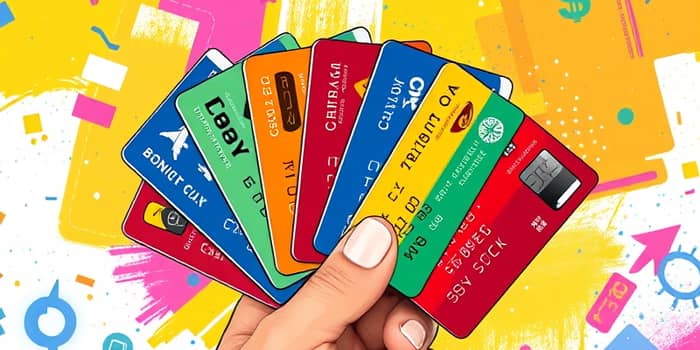Credit cards can unlock purchasing power and build credit when used responsibly. This guide explores the diverse options available and offers practical advice for choosing the ideal card.
Definition and Basics
A credit card is a financial tool issued by banks or credit unions that provides cardholders with a revolving line of credit for everyday purchases. These physical plastic or metal cards connect to major payment processors like Visa, Mastercard, American Express, and Discover, enabling transactions worldwide. Unlike debit or prepaid cards that draw on existing funds, credit cards allow users to borrow money up to a preset limit.
Each billing cycle, cardholders receive a detailed monthly statement and can choose to pay the full balance or a minimum amount, incurring interest on any remaining balance. Responsible use can improve credit scores, while missed payments or high utilization can hurt creditworthiness.
Major Types of Credit Cards
Credit cards come in various forms, each tailored to specific financial needs and goals. Understanding the major categories helps individuals match their spending habits, credit profiles, and desire for rewards or low costs.
- Rewards Credit Cards
- Low-Interest and Balance Transfer Cards
- Credit-Building Cards
- Business Credit Cards
- Specialty and Charge Cards
Rewards Credit Cards
Rewards cards are popular for their ability to deliver tangible returns on everyday spending. These cards typically require good to excellent credit and offer incentives such as cash back, points, or travel miles. Card issuers often provide sign-up bonuses and rotating bonus categories to boost initial rewards.
Common reward structures include cash back programs earning between 1% and 5% back on purchases, points-based schemes redeemable for merchandise or statement credits, travel rewards offering airline miles or hotel points, and retailer-specific store cards that confer special discounts or financing options.
While many rewards cards charge annual fees ranging from $0 to $550, the value from perks, companion tickets, and loyalty bonuses can far exceed these costs for savvy users.
Low-Interest and Balance Transfer Cards
For those who carry a balance or seek to consolidate debt, low-interest credit cards offer ongoing lower APRs or promotional 0% APR periods. Such cards commonly require good credit and may charge a one-time balance transfer fee. Understanding promotional terms and timing is crucial.
0% APR promotional periods for purchases or transfers can last from six to eighteen months, providing breathing room to pay down debt without accruing interest. Balance transfer fees typically range from 3% to 5% of the transferred amount, making it essential to calculate potential savings against these charges.
Credit-Building Cards
Secured cards and student cards are designed for individuals with limited or poor credit histories. Secured credit cards require a cash deposit, often between $200 and $500, which becomes the credit line. Responsible use and on-time payments can lead to credit limit increases and eventual graduation to unsecured cards.
refundable deposit used as credit line allows issuers to minimize risk while helping cardholders demonstrate payment reliability. Student credit cards offer lower credit limits and modest rewards, making them ideal for young adults starting their credit journey.
Business and Specialty Cards
Business credit cards cater to small business owners and corporate entities, offering higher credit limits, detailed expense reporting, and employee cards. They often include bonus rewards in categories like office supplies, advertising, and travel. Qualification depends on the business’s financials and personal credit score if the company lacks established business credit.
Specialty cards include charge cards that require full payment each month with no option to revolve balances, as well as co-branded cards affiliated with airlines, hotels, or retailers. These cards may carry higher fees but deliver premium travel perks and exclusive partner benefits that appeal to specific audiences.
Key Features and Benefits
Beyond core rewards and interest rates, credit cards provide a range of features that protect purchases and enhance convenience. Introductory offers and ongoing protections can outweigh annual fees when aligned with a cardholder’s spending patterns.
Common features include:
- Sign-up bonuses that yield value between $100 and $750 or more based on minimum spending requirements.
- Purchase protections like extended warranties, return guarantees, and price adjustment benefits.
- Travel perks such as rental car coverage, airport lounge access, TSA PreCheck or Global Entry fee credits, and trip cancellation insurance.
- Fraud prevention tools including zero liability policies and advanced security chips.
Fees and Costs
Understanding fees and costs is critical. Annual fees can range from $0 on basic cards to over $500 on premium rewards and charge cards. Interest rates typically vary from 15 to 25 percent APR rates on unpaid balances, while subprime or unsecured starter cards may charge higher APRs.
Other fees include balance transfer fees (usually 3%–5%), foreign transaction fees of up to 3%, late payment charges, cash advance fees, and over-limit penalties. Comparing fee structures can identify cards that align with a user’s financial habits.
Choosing the Right Card
Selecting an optimal credit card hinges on understanding individual goals, credit scores, and spending patterns. Factors to consider include:
- Average monthly spending and preferred reward categories such as travel, groceries, or dining.
- Credit score and eligibility requirements for desirable cards.
- Fees versus benefits, including annual fees, foreign transaction fees, and interest rates.
- Introductory offers like 0% APR periods or bonus point thresholds.
A thorough comparison of features, costs, and personal financial behavior ensures the chosen card will deliver maximum value over time.
Risks and Responsible Usage
While credit cards offer flexibility, misuse can lead to high-interest debt and damaged credit scores. Carrying a balance beyond promotional periods can quickly accumulate interest, and missed payments trigger late fees and potential credit report marks.
Practicing monitor credit utilization and pay on time strategies helps maintain or improve credit scores. Experts recommend keeping utilization below 30% of available credit and setting up automatic payments or reminders.
Conclusion
Credit cards, when selected wisely and managed responsibly, can be powerful tools for earning rewards, building credit, and simplifying expenses. By understanding financial habits and credit utilization ratios and aligning card features with personal goals, anyone can leverage the perfect credit card to achieve greater financial freedom.
References
- https://www.nerdwallet.com/article/credit-cards/types-of-credit-cards
- https://www.bankrate.com/credit-cards/advice/different-types-of-credit-cards/
- https://www.moneyhelper.org.uk/en/everyday-money/credit/simple-guide-to-credit-cards
- https://www.topsidefcu.org/blog/how-different-types-credit-cards-work-guide
- https://www.capitalone.com/learn-grow/money-management/types-of-credit-cards/
- https://www.collegeave.com/articles/credit-card-benefits-rewards-explained/
- https://www.investopedia.com/terms/c/creditcard.asp
- https://www.nerdwallet.com/article/credit-cards/credit-cards-101










